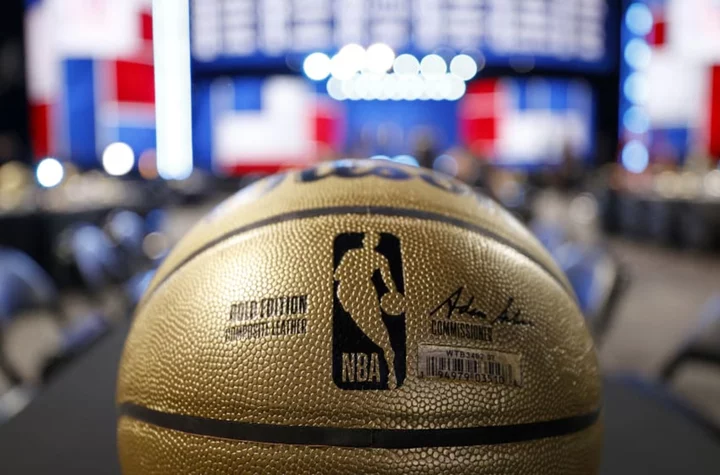The NBA hates this one simple trick by general managers! That statement may not be true, but should the NBA crack down on the relatively new practice of teams trading the same pick twice?
Three selections in the second round of the 2024 NBA Draft are going to be traded somewhere. Where depends on the trading club's draft position at the end of the season.
Yes, we're at a point in the protection of draft picks where teams are turning a single asset into two pieces of trade capital.
Trade it once, trade it twice, trade it once again
On Feb. 6, 2020, the Atlanta Hawks traded a heavily protected second-round pick (top-55 protected) to the Portland Trail Blazers for Skal Labissiere and cash considerations. But a little more than three years later, Atlanta traded the pick to the Blazers again, this time to pick up Gary Payton II, a Grizzlies 2026 second-round pick (top-42 protected) and Portland's 2028 second-rounder on Feb. 9, 2023.
The end result is simple enough: Portland gets the Hawks' 2024 second-rounder from one deal or the other.
Pat Riley of the Miami Heat did the Hawks one better, however. On Feb. 18, 2018, Riley sent his 2024 second-round pick with top-55 protection to the Cleveland Cavaliers to re-acquire franchise icon Dwayne Wade.
Then on draft night in 2019, Riley traded the pick again, this time with protection if it fell between 56th and 60th overall, to Atlanta for the Heat's 2019 second-round pick.
So either Miami ends up getting back the long-since-retired Wade or the 2019 second-round pick it used to take Oregon's Bol Bol for nothing or cash considerations, respectively.
To be fair, the second teams involved in these two examples knew what they were getting into. The previous protection of the picks were public knowledge and they signed off on the trades anyway.
The San Antonio Spurs used this same trick twice in 2023. On Jan. 5, 2023, they acquired Noah Vonleh from the Boston Celtics along with cash for a top-55 protected second-rounder from the Spurs. But on July 17, San Antonio also got Cameron Payne, a 2025 second-round selection and cash from the Phoenix Suns for the same second-round pick, protected 56-60.
Two players, a future second-rounder and a pair of cashed checks for a pick that only one of the teams involved in the trades will receive seems like quite the deal.
Pick protection began during the NBA's golden age of the 1980s
It is the latest iteration of an NBA practice that dates to the mid-1980s, when the Indiana Pacers and Dallas Mavericks agreed to a conditional trade based on the draft position of a traded first-round pick,
In this era, trading conditional draft picks wasn't uncommon. All free agency was restricted free agency at the time, with teams awarded compensation from clubs that signed their players to new contracts. That came after the team that had the player with the expiring deal had the right of first refusal and could match any offer sheet.
The Pacers in 1984 had just been burned by a trade from the distant past. In 1982, Indiana sent its first-round pick to the Trail Blazers for veteran journeyman center Tom Owens. Owens was going to replace James Edwards, who got an offer from the Cleveland Cavaliers that the Pacers opted not to match.
Indiana continued to be awful and its 1984 pick ended up in the coin flip for the No. 1 overall pick. Houston won the flip and took Hakeem Olajuwon. Portland chose next and selected Sam Bowie. Some guy named Michael Jordan went to the Chicago Bulls at No. 3.
It was that last part that likely prevented the Pacers from being skewered by the papers (the go-to for news in the dark ages before the Internet). Pundits were so busy piling on the Blazers that Indiana's gaffe was lost in the shuffle.
The trade in question between the Pacers and Mavericks sent a pair of young players who were not going to get minutes, big man Bill Garnett and guard Terence Stansbury, to Indiana for a 1990 first-round pick. However, if the Pacers' selection landed in the top seven, Dallas would instead receive Indiana's unprotected 1991 first-rounder.
And precedent was born.
An argument against pick protection
For the cynical among us, draft-pick protection can be interpreted as bad general managers hedging their bets. There is no greater example of this than former Los Angeles Lakers front-office boss Mitch Kupchak, who went all-in (sort of) in the summer of 2012 in an effort to maximize Kobe Bryant's title chances as his career wound down.
In July 2012, Kupchak traded his 2013 and 2014 second-round picks, his 2014 second-round pick and a protected 2015 first-round pick to the Suns in a sign-and-trade deal for point guard Steve Nash.
A month later, Kupchak wheeled and dealed his way into a four-team swap, sending Andrew Bynum to Philadelphia and Christian Eyenga, Josh McRoberts and a future No. 1 pick to the Orlando Magic to get Dwight Howard and some spare parts.
That first-round pick was to convey two years after the pick in the Nash deal went to Phoenix, unless it wasn't conveyed to Orlando by 2017. In that case, instead of a first-round pick, the Magic would get L.A.'s second-rounders in 2017 and 2018.
The Lakers collapsed in 2013-14 and the pick traded for Nash didn't arrived in Phoenix until all the protections had expired in 2018.
This is obviously a case where there is no putting the toothpaste back into the tube; pick protection isn't going anywhere.
But at the very least, the NBA could consider putting restrictions on GMs getting two trade assets for the price of one by outlawing the practice of inverted protection that allows them to deal the same selection twice.

